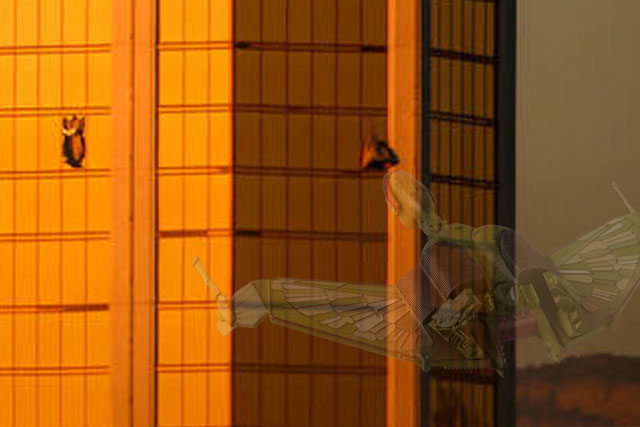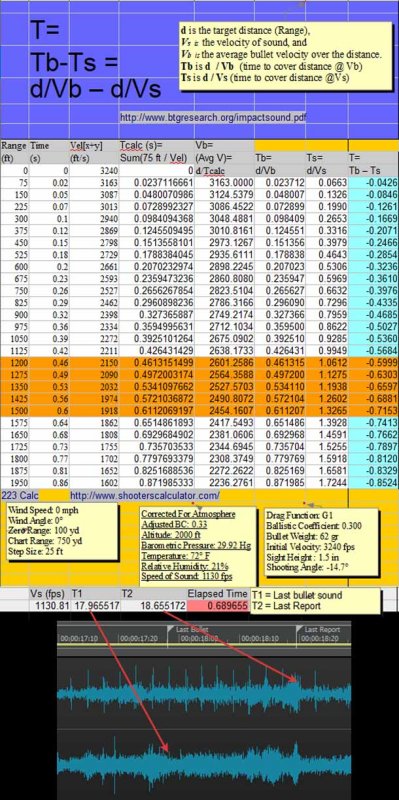United States News
See other United States News Articles
Title: Video claims shooter dressed as police
Source:
[None]
URL Source: https://duckduckgo.com/?q=LAS+VEGAS ... a=videos&iax=1&iai=qMxn7hpXmk4
Published: Oct 8, 2017
Author: Planet X Investigations
Post Date: 2017-10-08 15:41:01 by A K A Stone
Keywords: None
Views: 71781
Comments: 186
Video claims shooter dressed as police Poster Comment: Video claims shooter dressed as police
Post Comment Private Reply Ignore Thread
Top • Page Up • Full Thread • Page Down • Bottom/Latest
Begin Trace Mode for Comment # 145.
#1. To: A K A Stone (#0)
(Edited)
SMH. LOL.
You didn't have time to watch the video yet. Debunk it please.
It would be a positive number expression of time. On your spreadsheet chartoon, notice that you calculate T = Tb - Ts. You calculate elapsed time as the time it took the bullet to travel, minus the time it took the sound to travel. The correct formula should be T = Ts – Tb = d/Vs – d/Vb. As the bullet is supersonic, and sound is a constant, the sound would travel 400 yards in 1.06s and the bullet would travel in less than 1.06s. Subtracting 1.06 from a smaller number will always yield a negative number. At 1200 feet, you calculate Tb as 0.448578s, and Ts as 1.062s and calculate the T as -0.6126, negative 0.6126 seconds. The average donkey could recognize that something is wrong when the result is negative time. Just what do you think happens in negative 0.6126 seconds? You could at least recognize that if you get a negative number, you have stated the required formula backwards, and you proceeded to perform the calculation backwards, and present the bass ackwards result of your misunderstanding of the study you looked at. Moreover, while you state backwards that T = Tb - Ts, your spreadsheet never defines what T is supposed to represent. Negative 0.6126 is the time of what? What is the significance of this negative 0.6126 seconds (other than to demonstrate you did not understand the reference study)?
>>The correct formula should be T = Ts – Tb = d/Vs – d/Vb. Nope. You're not even reading from the relevant part of the paper - where the microphone adjacent to the victim scenario is discussed. http://ww w.btgresearch.org/AcousticReconstruction02042012.pdf That's the same formula I have in my illustration:
No, I read the correct part. The formula is correct for a supersonic bullet only if the value is explicitly expressed as an absolute. Otherwise, the correct value is derived by changing the formula. Either will work. You did neither and derived negative times and published them that way.
>>No, I read the correct part. LOL Here's what you quoted: ==================== A microphone was placed a few centimeters from the muzzle to record both the muzzle blast and the sound of the bullet hitting the deer. The time recorded between the muzzle blast and bullet striking the target represents the sum of the bullet time of flight (tb) and the time for the sound to return to the microphone from the target (ts), nolu chan posted on 2017-10-25 16:15:25 ET https://libertysflame.com/cgi- bin/readart.cgi?ArtNum=53025&Disp=120#C120 ==================== And this is the correct section of the paper that deals with a microphone AT THE TARGET, the scenario where the "shooter dressed as police" video in question was taken. http://ww w.btgresearch.org/AcousticReconstruction02042012.pdf >>The formula is correct for a supersonic bullet only if the value is explicitly expressed as an absolute The formula is fine just the way the authors of the paper wrote it. The negative time is perfectly acceptable IF you actually understand what the value and chart are saying: The sound of the Report (Ts) event was recorded 0.6126 seconds after Tb and that time differential corresponds to a distance of 1200 ft from the shooter.
Here's what you quoted: ==================== A microphone was placed a few centimeters from the muzzle to record both the muzzle blast and the sound of the bullet hitting the deer. The time recorded between the muzzle blast and bullet striking the target represents the sum of the bullet time of flight (tb) and the time for the sound to return to the microphone from the target (ts), t = ts + tb = d/Vs + d/Vb nolu chan posted on 2017-10-25 16:15:25 ET https://libertysflame.com/cgi-bin/readart.cgi?ArtNum=53025&Disp=120#C120 You are an ass. How many times did #120 explicitly say it was about your lame attempt to use the taxi video? The taxi was hardly at or near the origin point. It was 338+ feet away. The study placed a microphone "a few centimers" from the muzzle, not 10,302+ centimeters away. The taxi was 338 feet down, some distance out from the building. Even if directly opposite the taxi, the muzzle had to travel 338+ feet to get to the taxi. That still take 0.299 seconds for the muzzle blast to reach the taxi from 338 feet. Adjusting for your cited claim (at #118) that NYT reporting "suggests that Paddock was positioned directly above the camera at this point," with the taxi directly below the window, your blather has not materially changed the problem with your chartoon. The taxi microphone was not a few centimeters from the muzzle, it was over 338 feet away. The problem, of course, is related in your reference study. http://www.btgresearch.org/AcousticReconstruction02042012.pdf Using Sound of Target Impact for Acoustic Reconstructions of Shooting Events At page 2: t = ts + tb = d/Vs + d/Vb where d is the target distance, Vs is the velocity of sound, and Vb is the average bullet velocity over the distance. At page 5: At page 6: Your recording is at a taxi over 338 feet away from the muzzle. You can do all the calculations you desire and the microphone will be no closer to the muzzle. The muzzle was likely around the corner, about 338 feet up, and some angular distance away from the microphone in the taxi. The taxi did not pick up the sounds of the bullets striking people on the ground over 1200 feet away. The muzzle blast echoed back, but you do not know where from, or what path it took to the taxi at ground level. A taxi recording indicates the muzzle blast with a delay by the time the sound took to reach the taxi, about .299 seconds at 338 feet. During that delay, the muzzle blast is on its way to some reflective surface which redirects the sound by some route to the taxi at ground level. The elapsed time at the 338+ foot distant taxi is not the elapsed time of the muzzle burst soundwave out and back. You ignored the ~0.299 second initial delay to reach the taxi, and you have no idea what reflective surface(s) redirected the sound before the echo arrived at the taxi. You do have a nice picture with circles on it though. Also, as there was no firearm seen protruding from any window, if Paddock was the shooter, he and the firearm were inside the room. The sound of muzzle blast had to travel out through the hole in the window in a directional manner. No straight path to the taxi was available.
#146. To: nolu chan (#145)
(Edited)
>>How many times did #120 explicitly say { blah blah blah } You might want to rethink the value of quoting yourself to "prove" what someone else said. Doesn't seem to be working very well for you. The Taxi Video applies to The Test for ECHO meme - not to the video/audio being discussed in this thread which asserts that "shooter dressed as police". That "shooter dressed as police" ASSertion is CLEARLY refuted by the audio data. Audio data that I've analysed using the correct forumula - which works just fine without your tweakage. http://ww w.btgresearch.org/AcousticReconstruction02042012.pdf And that IS the same formula I have in my illustration:
Top • Page Up • Full Thread • Page Down • Bottom/Latest
#4. To: VxH (#1)
#119. To: A K A Stone (#4)
Debunk it please.

What would the Elapsed time between the Last Report sound event and the Last Bullet sound event be if, as the video alleged, the guy "dressed as police" was shooting?
#128. To: VxH, A K A Stone (#119)
What would the Elapsed time between the Last Report sound event and the Last Bullet sound event be....
#131. To: nolu chan (#128)
(Edited)


#135. To: VxH (#131)
You're not even reading from the relevant part of the paper - where the microphone adjacent to the victim scenario is discussed.
#136. To: nolu chan (#135)
(Edited)
t = ts + tb = d/Vs + d/Vb
#145. To: VxH (#136)
LOL
#120. To: VxH (#116)
Regarding my initial meme "TEST FOR ECHO" -- Balistic data is NOT required to determine the total distance sound traveling from, and echoing back to, the ORIGIN point which is essentially where the Taxi driver was.
Yeah, you make believe that the sounds recorded in the taxi can yield an accurate measurement of distance.
A microphone was placed a few centimeters from the muzzle to record both the muzzle blast and the sound of the bullet hitting the deer. The time recorded between the muzzle blast and bullet striking the target represents the sum of the bullet time of flight (tb) and the time for the sound to return to the microphone from the target (ts),
These results show that it is possible to use an audio recording of a shooting event to accurately determine the distance between the target and the shooter. In cases where the location of the microphone is different, the mathematical details are different, but the ideas are the same.
A significant weakness in the study is the placement of the microphone near the muzzle of the gun, an unlikely location in most forensic cases....
Replies to Comment # 145. 

End Trace Mode for Comment # 145.
[Home] [Headlines] [Latest Articles] [Latest Comments] [Post] [Mail] [Sign-in] [Setup] [Help] [Register]
